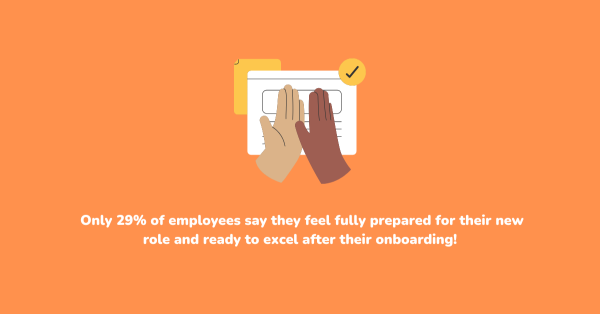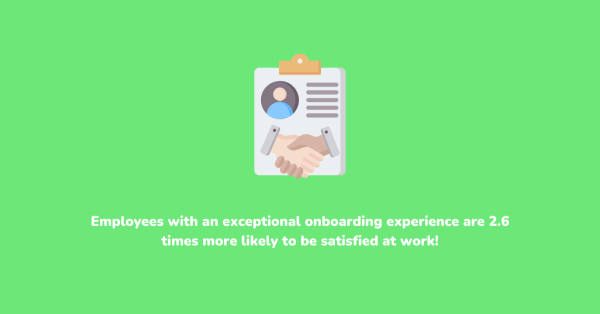Did you know that a significant number of new hires feel disengaged and uncertain during their first few weeks on the job? This period of uncertainty can even lead to some employees leaving before they truly get started. But what if there was a way to bridge the gap between accepting the job offer and the first day, setting the stage for a smooth transition and a positive employee experience? That's where employee preboarding comes in.
Employee preboarding is the crucial step before onboarding, focusing on engaging your new hires and preparing them for their roles prior to their official start date. Think of it as rolling out the welcome mat and giving your new team members a sneak peek into your company culture and their future role. It's a chance to build excitement, alleviate first-day jitters, and start fostering a sense of belonging from the moment they say "yes."
By implementing a well-structured program, you can reap significant benefits, including:
-
Increased Employee Engagement - It helps new hires feel connected to the company and their team from the start, fostering a sense of belonging and purpose.
-
Reduced Anxiety and Turnover - Addressing new hire concerns and providing clear expectations beforehand can significantly reduce first-day jitters and decrease early employee turnover.
-
Faster Time to Productivity - By providing necessary information and resources in advance, you enable new hires to hit the ground running and contribute to the team more quickly.
Why is Preboarding Important?
Imagine starting a new job feeling lost and unsure. You're excited about the opportunity, but you also have a million questions swirling in your head. Will you fit in with the team? What exactly are your responsibilities? Where's the coffee machine?
Now imagine a different scenario. Before your first day, you receive a warm welcome message from your manager, get introduced to your team members online, and have access to resources that answer your most pressing questions. You even get a glimpse into the company culture and values, giving you a sense of belonging even before you step foot in the office. Which scenario do you think would lead to a more positive and productive start?
That's the power of preboarding. It's not just a nice-to-have; it's a strategic investment for a good onboarding process for your new hires and your organization's success. Here's why:
-
Reduce New Hire Anxiety and Turnover - Starting a new job can be stressful. Preboarding helps alleviate those anxieties by providing clarity and support from the very beginning. When new hires feel informed and prepared, they are less likely to experience doubt or regret, leading to lower early turnover rates.
-
Improve Employee Engagement - Employee preboarding sets the stage for a positive employee experience. By fostering a sense of connection and belonging before day one, you can significantly increase engagement levels and create a more motivated workforce.
-
Accelerate Time to Productivity - Employee preboarding allows you to front-load essential information and resources, enabling new hires to get up to speed faster. This means they can contribute to the team and achieve their goals more quickly, benefiting both the individual and the organization.
-
Enhance the Candidate Experience - In today's competitive job market, a positive candidate experience is crucial. A structured program demonstrates your commitment to your new hires and reinforces their decision to join your company. This can have a lasting impact on their perception of your organization and their overall job satisfaction.
-
Reinforce the Hiring Decision - The period between accepting a job offer and the first day can be filled with uncertainty for new hires. A structured program helps maintain their excitement and reinforces that they made the right choice by joining your team. It's a chance to build confidence and anticipation for their new role.
By investing in a comprehensive program, you're not just filling the gap between the offer and the start date, you're laying the foundation for a successful, engaged, and productive workforce.
The Preboarding Process

It is a multifaceted process, requiring careful planning and execution. It's more than just sending a welcome email, it's about creating a structured onboarding experience that engages your new hires from day 1 and prepares them for success. Here's a step-by-step guide to help you build a truly effective program:
-
Step 1: Welcome and Introduction
-
First impressions are crucial, and the initial period is your opportunity to make a positive and lasting impact. Begin by sending a personalized welcome message to your new hire, expressing your enthusiasm about them joining the team. Avoid generic templates; instead, craft a message that reflects your company culture and the new hire's unique role.
-
In your welcome message, introduce yourself as their manager or a key point of contact and provide your contact information, encouraging them to reach out with any questions or concerns they may have. To further personalize the experience, consider including a welcome video from the CEO, a team member, or even a compilation of short clips from different departments. This adds a human touch and helps the new hire feel connected to the organization from the start.
-
Step 2: Paperwork and Logistics
-
The initial period is the ideal time to handle administrative tasks and provide essential logistical information. This allows your new hires to focus on more engaging aspects of their onboarding experience once they officially start.
-
Guide them through the completion of necessary paperwork, such as tax forms, benefits enrollment, and policy acknowledgments. Ensure these documents are easily accessible and provide clear instructions on how to fill them out.
In addition to paperwork, provide comprehensive information about logistical details, including their start date, office location (if applicable), parking arrangements, dress code, and any other relevant information that will help them prepare for their first day. Consider creating a checklist or FAQ document to ensure they have all the necessary information readily available.
-
Step 3: Company Culture and Values
-
Immersing your new hire in your company culture is a vital aspect of this program. Share resources that showcase your organization's mission, vision, and values towards a people-focused business. This could include your company website, blog posts, social media pages, employee testimonials, or even a virtual tour of the workplace.
-
Consider creating a "culture deck" or a short video that highlights your company's unique identity and what it's like to work there. This helps new hires understand the company's values, work environment, and overall atmosphere, fostering a sense of belonging and alignment with the organization's goals.
-
Step 4: Team Introduction and Connection
-
Facilitating connections with future colleagues is essential for building rapport and creating a sense of community before the new hire's first day. Introduce them to their team members and key stakeholders through various channels.
-
Email introductions are a good starting point, but consider more interactive approaches like virtual coffee chats, team lunches (if feasible), or a dedicated channel on your company intranet where they can connect with their team members. Encourage existing employees to reach out and welcome the new hire, fostering a sense of inclusion and camaraderie.
-
Step 5: Role Expectations and Resources
-
Setting clear expectations is crucial for a successful onboarding experience. Provide a detailed outline of the new hire's role, responsibilities, and performance expectations. This helps them understand their contribution to the team and the organization as a whole.
-
In addition to outlining their responsibilities, grant access to relevant resources, tools, and training materials they may need to familiarize themselves with their role. This could include access to internal systems, software tutorials, or online courses related to their job function.
-
Step 6: Preboarding Activities and Engagement
-
To maintain excitement and engagement throughout the initial period, consider incorporating interactive activities. This could include quizzes about company history, surveys about their interests, or online learning modules related to their role.
-
Gamification elements can also be incorporated to make the experience more enjoyable and encourage active participation. For example, you could create a points system for completing preboarding activities or offer small rewards for active engagement.
By following these steps and dedicating time and effort to your program, you can create a structured and engaging experience that sets the stage for a smooth transition and a successful onboarding journey for your new hires.
Preboarding Best Practices
You understand the benefits of preboarding and the key steps involved. Now, let's delve into some best practices to ensure your program is truly effective and sets your new hires up for success from day one.
Personalization is Key
In the age of automation and standardized processes, it's easy to forget the importance of the human touch. Remember that each new hire is an individual with unique needs, expectations, and backgrounds. Avoid a generic, one-size-fits-all approach and instead create a custom invitation tailored to their specific circumstances.
Personalization goes beyond simply addressing the new hire by name. Consider their role, their previous experience, and any specific concerns they might have expressed during the interview process. Provide relevant resources, tailor your communication style, and demonstrate a genuine interest in their individual needs to create a truly welcoming and engaging experience.
Communication is Crucial
Consistent and clear communication is the cornerstone of an effective program. Regularly check in with your new hire, even if it's just a brief email to see if they have any questions or concerns. Respond promptly to their inquiries and provide updates on any relevant developments, such as changes to their start date or office location.
Consider scheduling a quick phone call or video chat to establish a personal connection and address any anxieties they might have. This open communication fosters trust, builds rapport, and reinforces your commitment to their successful onboarding.
Leverage Technology
Technology can be a powerful ally in streamlining and automating your process. Preboarding software can automate repetitive tasks such as sending welcome emails, collecting paperwork, providing access to resources, and tracking progress. This not only saves you valuable time but also ensures a consistent and efficient experience for all new hires.
Explore different preboarding software and choose one that aligns with your needs and budget. Many options offer features such as customizable workflows, automated reminders, and integration with your existing HR systems. By leveraging technology, you can free up your time to focus on more strategic initiatives, such as building relationships with your new hires.
Encourage Feedback
Feedback is a goldmine for continuous improvement. Encourage your new hires to provide honest feedback on their experience. Ask them what they found helpful, what could be improved, what information they were missing, and any suggestions they might have.
You can gather feedback through surveys, one-on-one conversations, or even informal feedback channels. Actively listen to their input and use it to refine your program and ensure it meets the evolving needs of your new hires. This demonstrates your commitment to their experience and creates a culture of continuous improvement.
Measure Your Success
To truly understand the effectiveness of your program, you need to measure its impact. Track key metrics such as engagement levels, time to productivity, and new hire feedback to assess the success of your efforts.
Monitor how quickly new hires are completing preboarding activities, how engaged they are with the provided resources, and how satisfied they are with the overall experience. This data will help you identify areas for improvement, demonstrate the value to your organization, and justify further investment in your program
By implementing these best practices, you can create a program that not only welcomes your new hires but also sets them up for a successful and fulfilling career at your company. A well-structured program is an investment in your employees and a testament to your commitment to their long-term success.
Preboarding for Remote Employees

With the rise of remote work, preboarding takes on new dimensions. You're no longer just welcoming someone to a physical office, you're welcoming them into a virtual workspace and a potentially dispersed team. This presents unique challenges and opportunities.
Unique Challenges of Preboarding for Remote Employees
Remote employees may face challenges that their in-office counterparts don't. They might feel isolated or disconnected from the team, struggle to set up their home office effectively or have difficulty accessing the necessary technology and resources. It's essential to address these challenges proactively during the process.
Tips for Successful Remote Preboarding
-
Prioritize Communication - Regular and clear communication is even more critical for remote employees. Schedule virtual meetings, use instant messaging platforms, and encourage frequent interaction to build rapport and foster a sense of belonging.
-
Facilitate Virtual Introductions - Help your remote employees connect with their team members and key stakeholders through video calls, online team-building activities, or virtual coffee chats. This helps them build relationships and feel part of the team, even from afar.
-
Provide Clear Guidelines and Expectations - Ensure your remote employee has a clear understanding of their role, responsibilities, and performance expectations. Provide detailed guidelines on communication protocols, working hours, and any other relevant policies.
-
Offer Technical Support - Assist your remote employee in setting up their home office and accessing the necessary technology and resources. Provide clear instructions, troubleshooting guides, and IT support contacts to ensure a smooth and frustration-free experience.
-
Foster a Sense of Community - Encourage participation in virtual social events, online team-building activities, or mentorship programs to help your remote employee feel connected to the company culture and build relationships with their colleagues.
Tools and Resources for Remote Preboarding
-
Video Conferencing Platforms - Use tools like Zoom, Google Meet, or Microsoft Teams for virtual meetings, team introductions, and one-on-one check-ins.
-
Collaboration Tools - Utilize platforms like Slack, Microsoft Teams, or Google Workspace to facilitate communication, collaboration, and knowledge sharing among team members.
-
Project Management Tools - Introduce your remote employee to project management tools to help them stay organized and track their progress.
-
Online Learning Platforms - Provide access to online courses, training materials, and onboarding resources through platforms like Coursera, Udemy, or your company's learning management system.
By acknowledging the unique needs of remote employees and implementing these tips and tools, you can create a welcoming and engaging experience that bridges the distance and sets them up for success in their remote role.
Why OrangeHRM?
Are you looking to streamline your HR processes and create a seamless onboarding experience for your new hires? OrangeHRM is your all-in-one solution for efficient and engaging human resources management. Our comprehensive Onboarding module, complete with preboarding capabilities, empowers you to automate tasks, reduce paperwork, and provide a personalized welcome experience for every new employee. Ready to transform your onboarding experience and boost new hire engagement? Book a FREE demo today and discover how OrangeHRM can help you build a world-class onboarding program.
